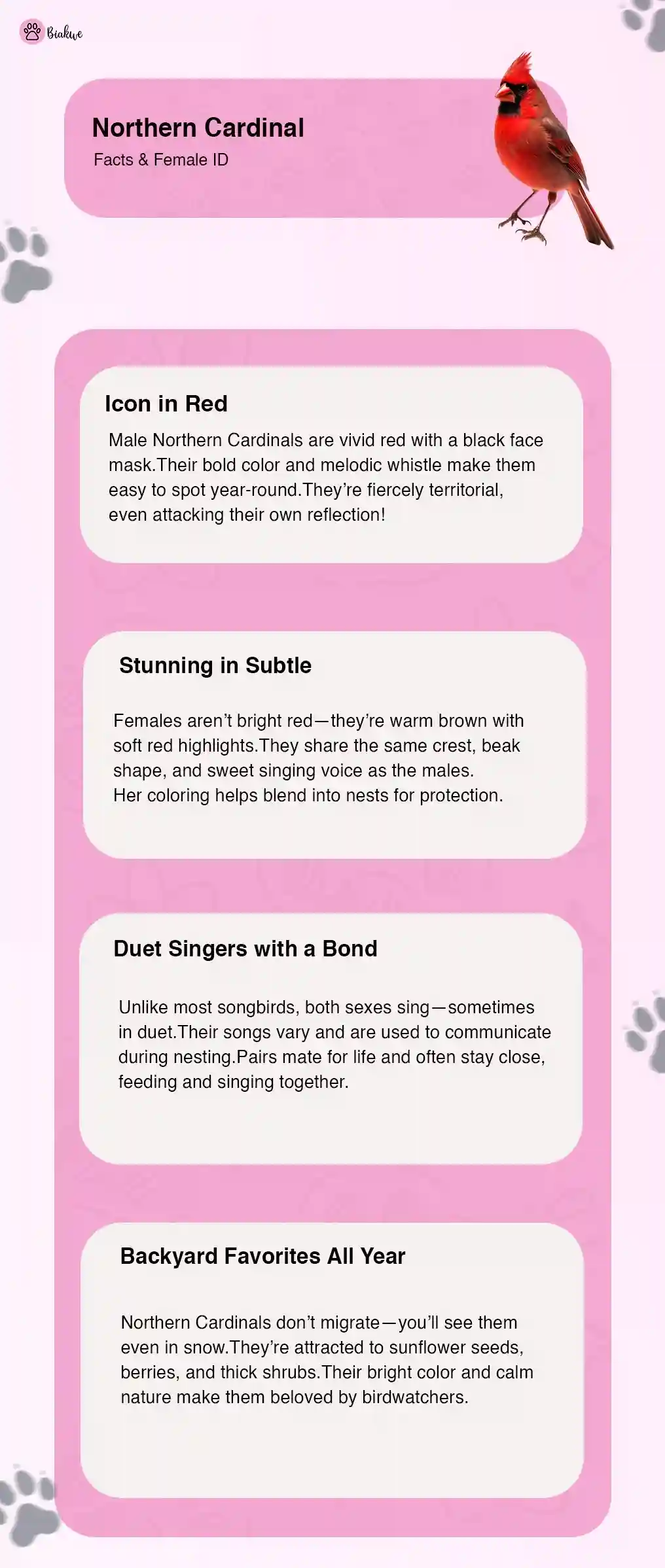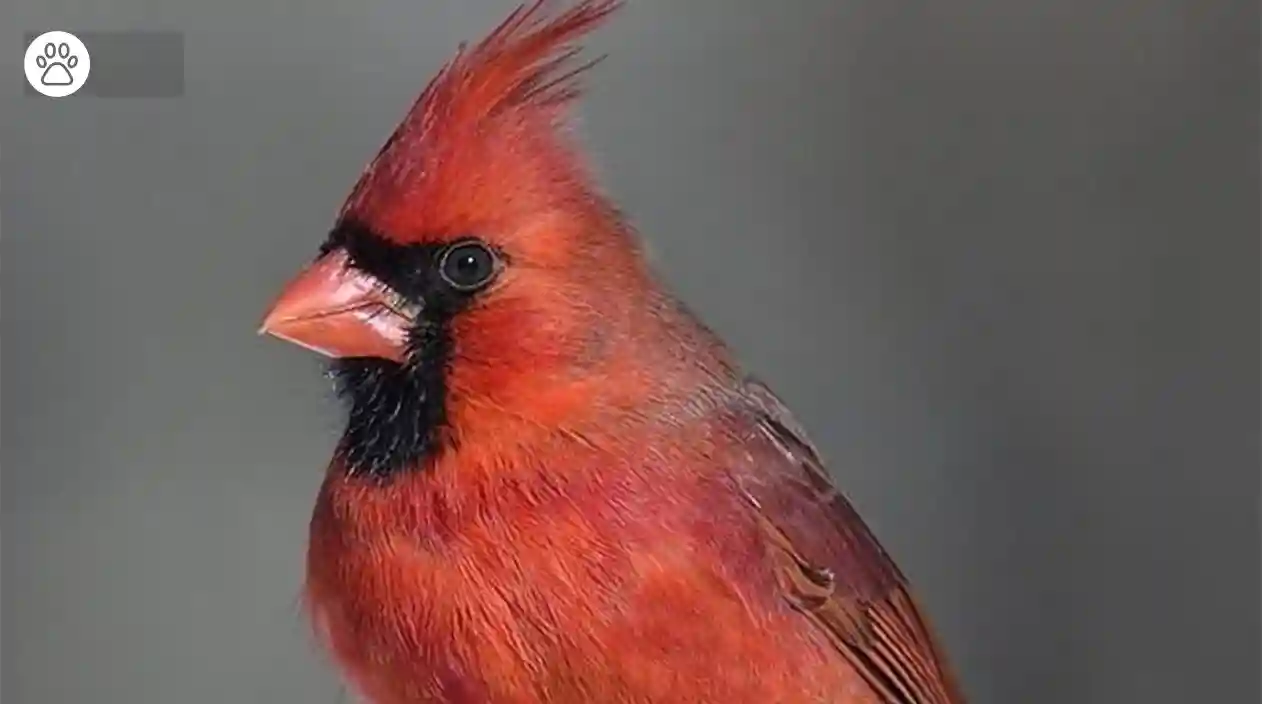A Flash of Red in the Snow
Consider a snowy morning when the world is seamless white, and all around is abruptly alive when a vibrant bird rests on a tree branch. This phenomenon, which defies nature’s norm, is nothing short of joyous to behold. Northern cardinals and their stunning form, along with melodious calls, are found in the backyards of homes across the entire United States.
“The cardinal sings not because it has answers, but because it has a song.”
This statement best sums up our cherished friend, the vibrant red bird, who never fails to brighten the mood with his calls and is guaranteed to put a smile on anyone’s face.
Overview of The Northern Cardinal
The Northern Cardinal, or as it is scientifically known, Cardinalis cardinalis, is a songbird of moderate size that resides in North America. The male cardinal certainly stands out because of his bright red plumage and distinguishing crest. Even though the females lack vibrance, they still possess a degree of grace.
As non-migratory birds, cardinals do not leave their habitats for other areas. Because of this trait, cardinals are present in many regions throughout the year. They are particularly easier to spot during the winter when the red feathers of the male cardinals are beautifully set off against the white snow.

Recognizing The Female Northern Cardinal
Lack of adornments on females doesn’t mean they are uninteresting. Females possess features that are mesmerizing in their own right, and that is why it is best to have a look before going into details.
Primary Attributes
- Coloration: Cardinals of the female species possess distinctive features like tint. Their coloration can be described as a reddish yellow with light brown in all the other regions. This particular color code is known as ‘Peru’ and is a warmer hue. It is accompanied by red color conspicuously visible on the wings, tail as well and crest.
- Beak: A stout and solid beak also distinguishes the two forms of the birds. It is orange in color and measures around 1 inch in height. It ideally cracks seeds and, hence, is a necessity for the Northern Cardinal bird.
- Crest: Like most other cardinals, they both possess sharp crests. Unlike females, males possess sharper crests that are prominent above.
Visit: Blue Jay Bird: Diet, Feathers and Symbolism
Behavior
Songs and tunes are extremely essential for complex social criticism, which defines the cardinal species. Female northern cardinals perform that which is rarely observed: they sing, especially while tending to their nest. To some extent, the latter is done to alert the assumed wife regarding whether food is available or there are potential dangers nearby.

Habitat and Range
Woodlands, gardens, wetlands, and shrublands are just a few places where the northern cardinal is known to thrive as it adapts beautifully to new environments. Its range includes southern Canada as well as more eastern areas, including the central United States, and stretches further into Mexico and Central America.
Cardinals tend to prefer dense shrubs and foliage, which serve the dual purpose of providing shelter and nesting opportunities. They are often spotted in suburban areas, which makes them a popular subject among bird watchers.
Diet and Feeding Habits
A cardinal’s diet primarily consists of seeds, grain, and fruits. Their conical cardinal beak enables them to take tough seeds and fissure open their shells. To satisfy the growing chicks during the breeding season, the female cardinals increase their intake of insects for the necessary protein.
In order to draw the cardinals to your backyard, do the following:
- Feeders: Set out feeders that have safflower seeds, sunflower seeds, or peanuts.
- Native Plants: Plant serviceberries or dogwood, which are berry-producing shrubs.
- Water: A birdbath should be set out, especially during warmer months.
Reproduction and Nesting
The term ‘life-long monogamous’ describes the behavioral traits of this bird. They can have up to three broods per year, starting early spring.
- The Nests: Nests are built by females within dense trees and shrubs from twigs, grass, and leaves.
- Eggs: A female cardinal can lay up to 5 eggs and takes around 12 to 13 days to incubate them.
- Parental Roles: For the first few weeks, the nest is guarded and supplied with food by the male while the female incubates and later feeds them.

Vocalization and Communication
The northern cardinal bird is particularly recognized for the most beautiful songs. Their songs are sung by both males and females, which is really peculiar for string birds. In addition, these songs are sung to defend territory and also between mates.
One can listen to their splendid and clear whistling technique, such as said in words as cheer, cheer, cheer or birdie, birdie, birdie.
Cultural Significance
The northern cardinal is emblematic of deep social folklore. Red cardinals are considered symbols of love and family in Native American folklore, while Christians see the bird as a reminder of the lord’s passion, given its red color.
Some states, including Illinois, Indiana, and Kentucky, have adopted them as their state bird. Their bright color and visibility throughout the year transform them into symbols of hope and tenacity.
Discover: Red Headed Woodpecker: Habitat, Diet and Fun Facts
Current Status of Conservation
The IUCN has categorized this bird as a species of ‘least concern’. Their population is stable, and they are well-suited to living in cities and suburbs.
In order to conserve their numbers:
- Maintain their habitat: Grow dense shrubs and native plants.
- Limit the use of pesticides: Young cardinals need insects to survive, which is why pesticides are harmful.
- Window collisions: Use window decals or films to reduce the amount of reflective glass collision.
Conclusion
The northern cardinal not only represents a striking bird but also a bird that combines inner beauty and intricacies of nature, as a year-round symbol of warmth and resilience. The presence of cardinals enriches every yard that they stop by, showcasing their vibrant red feathers, performing captivating behaviors, and singing in a manner that is unlike any other.
Appreciating keen cardinal facts, such as identifying female northern cardinals, helps bird lovers broaden their perspective. These birds are known to create timeless memories, from being fed in winter to being listened to in the spring when they sing. Bird watchers and enthusiasts make sure to sustain cardinals for many generations to enjoy by providing aid to their nursery.
For more information about pets, visit Biakwe.
